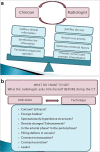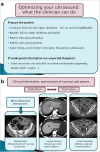Learning How to Order Imaging Tests and Make Subsequent Clinical Decisions: a Randomized Study of the Effectiveness of a Virtual Learning Environment for Medical Students
- PMID: 34457904
- PMCID: PMC8368962
- DOI: 10.1007/s40670-020-01188-5
Learning How to Order Imaging Tests and Make Subsequent Clinical Decisions: a Randomized Study of the Effectiveness of a Virtual Learning Environment for Medical Students
Abstract
Rationale and objectives: Two critical skills that medical students must acquire during undergraduate education are the ability to order imaging tests and make clinical decisions based on their results. We implemented an e-learning course in Moodle specifically designed to teach these skills to medical students. The aim of this study was to assess the effectiveness of our course.
Material and methods: We randomized 26 undergraduate medical students to an experimental group that had access to the virtual learning environment and a control group that did not. Three weeks after the course, we evaluated its effectiveness through a blinded objective structured clinical examination. To avoid any bias in favor of the experimental group, the assessment considered scores on two pre-specified subscales: one related to the contents of the course and the other to new clinical scenarios.
Results: Students that completed the e-course performed better overall than controls (mean score ± standard deviation 59.3 ± 6.2 vs 41.8 ± 10.2, p = 0.0020). This better performance was observed in both types of skills assessed (ordering imaging tests, and making diagnostic and therapeutic decisions based on test results). More importantly, this better performance of the experimental group was observed consistently both with items related to the course content (1.7 times higher, p = 0.0034) and new scenarios (1.3 times higher, p = 0.0098).
Conclusions: Through an ad - hoc e-course, undergraduate medical students learned effectively how to order imaging tests and make optimal subsequent decisions. Moreover, they were able to apply these skills to new clinical scenarios.
Keywords: Clinical decision-making; Medical education; Online education; Randomized controlled trial.
© International Association of Medical Science Educators 2021.
Conflict of interest statement
Conflict of InterestThe authors declare that they have no conflict of interest.
Figures






Similar articles
-
The virtual patient as a learning tool: a mixed quantitative qualitative study.BMC Med Educ. 2018 Dec 6;18(1):297. doi: 10.1186/s12909-018-1395-8. BMC Med Educ. 2018. PMID: 30522478 Free PMC article.
-
Student and educator experiences of maternal-child simulation-based learning: a systematic review of qualitative evidence protocol.JBI Database System Rev Implement Rep. 2015 Jan;13(1):14-26. doi: 10.11124/jbisrir-2015-1694. JBI Database System Rev Implement Rep. 2015. PMID: 26447004
-
Preparing medical students to teach.Acad Med. 2002 Nov;77(11):1175-6. doi: 10.1097/00001888-200211000-00046. Acad Med. 2002. PMID: 12431958
-
Effectiveness of high fidelity simulation versus low fidelity simulation on practical/clinical skill development in pre-registration physiotherapy students: a systematic review.JBI Database System Rev Implement Rep. 2019 Jun;17(6):1229-1255. doi: 10.11124/JBISRIR-2017-003931. JBI Database System Rev Implement Rep. 2019. PMID: 30964770
-
Perceptions of medical students towards and effectiveness of online surgical curriculum: a systematic review.BMC Med Educ. 2021 Nov 11;21(1):571. doi: 10.1186/s12909-021-03014-x. BMC Med Educ. 2021. PMID: 34763706 Free PMC article.
Cited by
-
Exploring medical students' metacognitive and regulatory dimensions of diagnostic problem solving.Med Educ Online. 2023 Dec;28(1):2210804. doi: 10.1080/10872981.2023.2210804. Med Educ Online. 2023. PMID: 37198958 Free PMC article.
-
What works in radiology education for medical students: a systematic review and meta-analysis.BMC Med Educ. 2024 Jan 10;24(1):51. doi: 10.1186/s12909-023-04981-z. BMC Med Educ. 2024. PMID: 38200489 Free PMC article.
References
-
- Ruiz JG, Mintzer MJ, Leipzig RM. The impact of E-learning in medical education. Acad Med. 2006;81(3):207–12. - PubMed
LinkOut - more resources
Full Text Sources
